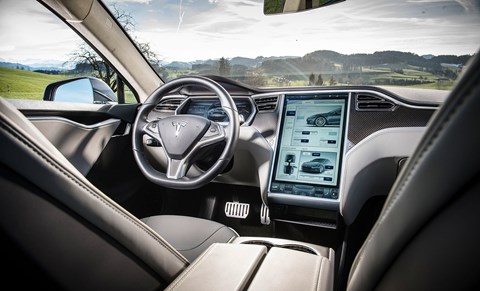► We drive the Tesla Model S P90D
► Optimistic mile estimator causes anxiety
► Breathtakingly fast electric vehicle
Bugatti offers three test-drive routes to prospective customers; 20 minutes, an hour or two hours. Believe it or not most plump for the quickie – it seems you need only taste 1480bhp once to know that you need it. In that respect the quad-turbo, 8.0-litre W16 Chiron is uniquely placed as a leviathan of instant test-drive appeal. But the P90D Model S Tesla (with £8700 Ludicrous upgrade in place) is an unlikely rival for mind-scrambling first impressions, and the almost immediate creation of wanton desire.
Approach the car and the door handles extend from the body to greet you: neat, but hardly a game-changer. You then slide aboard, smile dumbly at the enormous touchscreen and nonchalantly nudge into D – no ignition key, no handbrake, no clutch. Then it’s just you, your nearest and dearest and a near-silent and apparently bottomless well of drive. Thump the pedal to the floor and, with all-wheel drive and launch control, 60mph comes up in 2.8 seconds (3.1sec without the Ludicrous option).
If anything the sensation is more organ-pulpingly spectacular than those numbers would suggest. And should some last bastion of nonchalance be holding out somewhere in your thinking, determined not to give in to a machine that can comfortably seat five (seven with optional rear-facing third row) and eclipse an F12tdf Ferrari away from the lights, there’s Autopilot (a £2200 option).
Push the button and, for miles at a time on dual carriageways and motorways the Model S will drive itself, monitoring its speed, the gap to the car in front and its position within your chosen lane. Nudge the indicator and, on checking it’s safe to do so, the Tesla will change lanes. Just as firing up cruise control in any other car relieves a little of your brain’s workload, reducing fatigue, so Autopilot effectively doubles your range as driver. 120 miles before breakfast? Easy.
But while the P90D changes almost everything, it takes less than 24 hours to become comfortable with, and even dependent upon, the car’s remarkable capabilities. Where the lesser Model S is rear-wheel drive, the P90D’s twin motor set-up means it’s more than capable of deploying its savage thrust in all weathers. The sense of calm and of soothing superiority that breeds is magical.
That traction is allied to fine steering, a pretty impressive ride given the enormous optional 21-inch wheels (on £2200 air suspension) and body control that encourages faintly outrageous corner speeds. The powertrain’s pronounced regenerative braking on a closed throttle encourages very satisfying single-pedal progress. Nudging into Autopilot becomes second nature whenever conditions allow. And as you’d imagine, with no onboard combustion engine the level of refinement is Bentley blissful.
Range anxiety? It will creep in, especially with that cell-draining acceleration on tap. The car’s estimations are invariably optimistic, with one fairly restrained 90-mile motorway drive in our tenure draining a predicted 150 miles of range. But home charging is a breeze (a three-pin plug, your last resort, delivers 6 miles for every hour on charge), avoiding petrol stations an unexpected joy, Tesla’s supercharger network (an 80% charge in 30 minutes) loosely established and expanding, and the third-party charger map already reassuringly populated.

The specs: Tesla Model S P90D
Price: £86,800 before grant
Engine: Twin e-motors, 525bhp, 713lb ft
Transmission: All-wheel drive
Suspension: Double wishbone front, multi-link rear
Performance: 2.8sec 0-60mph, 155mph, n/a mpg, 0g/km CO2
Weight: 2200kg
On sale: Now
Love: Refinement, semi-autonomous ease, performance, style
Hate: Price, unhelpfully optimistic range predictor
Verdict: An expensive giant leap
Rating: *****
Read more from the April 2016 issue of CAR magazine